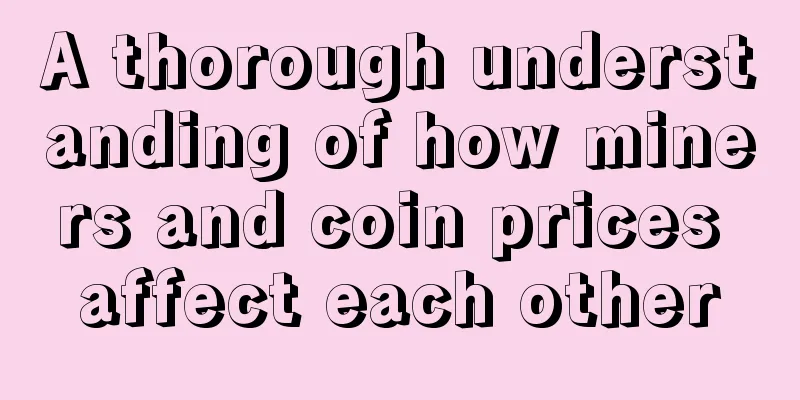A thorough understanding of how miners and coin prices affect each other

|
The next Bitcoin halving will take place on May 15, but there have been two opinions on how the halving will affect the price of Bitcoin. One view is based on the efficient market hypothesis, which holds that the halving has already been priced into the price of the currency by market participants. The other view is that it has not yet been fully priced into the price of the currency, and once people realize the scarcity caused by the reduction in supply, the halving will lead to a further increase in the price of the currency. The existence of these two voices is partly due to limited historical data. Bitcoin has only experienced two halvings in its history, and only a few cryptocurrencies that use the PoW mechanism have experienced the same event. This article analyzes miner economics based on a first principles framework and understands how miner behavior and coin prices affect each other, as well as how to better cope with the upcoming halving. Three miners' assumptions and inferences Below are three assumptions about miners as a starting point for further reasoning to understand miner economics. These three assumptions are generally correct, but may not apply to some miners, of course, the number of these miners is small. Assumption 1: Miners seek to maximize profits, which is a kind of economy of scale Mining is now difficult and resource-intensive, so individuals or amateurs can no longer participate. In contrast, mining is a large-scale economy of scale. Large miners deploy mines in areas with cheap electricity prices, negotiate with power companies for lower electricity prices, purchase a large number of the most efficient mining machines, and rent large mines. Large-scale mining reduces the cost of mining a single bitcoin. Since mining is a competitive industry, miners seek to maximize profits. Miners do not operate for ideological or altruistic purposes. If they cannot make a profit, they will not operate. Assumption 2: The total mining reward is fixed, and miners receive rewards in a certain proportion The issuance of Bitcoin is already specified by the Bitcoin protocol. The current Bitcoin block reward is 12.5, and the mining difficulty is adjusted regularly, with an average of one block every 10 minutes. All miners are competing for this reward and transaction fees. The reward income received by all miners in a given time period is predetermined. Assumption 3: Miner income is in cryptocurrency, while miner costs are in fiat currency Miner income consists of block rewards and transaction fees, both of which are denominated in cryptocurrency. Mining costs include mining machines, electricity, facility rental fees, maintenance fees, internet fees, wages, insurance, legal service fees, taxes, etc. These costs are calculated in fiat currency because most traditional companies do not currently accept cryptocurrency payments, such as power companies not accepting Bitcoin payments. Even if some costs can be paid in cryptocurrency, such as miners using cryptocurrency to pay for mining machines or employee wages, they are still quoted in fiat currency. Based on the above assumptions, we can draw the following inferences. Corollary 1: Mining is an almost perfectly competitive industry Based on the first two assumptions, the first inference is that mining is carried out in an equilibrium of almost perfect competition, with each miner facing a market price equal to the miner's marginal cost. This is achieved through two mechanisms. First, when mining is profitable, miners who seek to maximize profits will enter the industry or invest more mining machines, and when it is unprofitable, they will exit the industry or shut down mining machines. Second, changes in computing power trigger difficulty adjustments, constantly making the cost of mining a Bitcoin equal to the current market price. In the long run, mining is a zero-sum game. Because each miner is competing with other miners for the same block reward. In the long run, miners can only obtain average profits and only receive corresponding opportunity costs and risk compensation. Due to the high competition among miners, the final long-term equilibrium is that the profit margins of miners are very small and close to zero. But due to the inherent delays in the system, miners’ profits may fluctuate around equilibrium, which has an important impact on miners’ selling pressure. In addition, upstream industries such as mining hardware and semiconductor manufacturers have shown market monopoly. Based on the supply chains of these giants, some mining farms (such as Bitmain's) can use new mining machines for mining earlier than their competitors, which reduces the degree of perfect competition in mining. Corollary 2: Miners are a continuous and significant source of selling pressure Combined with the third assumption, an important inference can be drawn: miners are the largest group of sellers. The selling pressure from miners is huge because miners must sell the cryptocurrencies they mine to pay for real-world expenses. And because their profit margins tend to zero, miners must sell almost all the cryptocurrencies they earn. Miners earned nearly $5.5 billion in 2019. Researchers previously compared this figure to Bitcoin’s annual transaction volume, which is several orders of magnitude larger than miners’ revenue, and concluded that miner-led selling pressure has a negligible impact on the Bitcoin market. However, miners selling coins is a net capital outflow, and the fiat currency they receive from selling coins is unlikely to return to the market, while other transactions are not necessarily the case. Therefore, miners selling coins actually has a huge impact on the market. Currently, users have about 1 million bitcoins stored in Coinbase. At current prices, this is equivalent to $6.5 billion, which is not much different from the annual income of miners in 2019. If it is assumed that miners will sell most of the cryptocurrencies they mine, the selling pressure from miners is almost equivalent to all Coinbase users selling their bitcoins in one year and permanently exiting the market. Assuming that the price of Bitcoin remains at current levels after the halving, we can extrapolate the miner revenue for 2020. Under these assumptions, we can find that the selling pressure in 2020 will be significantly reduced, only half of the Bitcoin held by Coinbase. Inference 3: Miners have a cyclical impact on Bitcoin prices The reality is that miners’ profits will fluctuate greatly. Factors that affect miner costs are slow-moving and have a lag effect. Decisions to enter or exit, to buy mining machines to expand, take time. Difficulty adjustments have a delay of about two weeks. Revenues change quickly because the main determinant of revenue is the price of Bitcoin, which is extremely volatile, often with fluctuations of more than 50%. These factors cause profits to change, which means that the selling pressure on miners due to their fixed costs denominated in fiat currency will also change. When prices fluctuate particularly greatly or unilaterally over a period of time, miner profits may remain positive or negative for a considerable period of time. This is more likely to occur when prices are rising, because the delays of more capital being invested in mining machines are more prominent than the delays when prices are falling. When the price of the currency is lower than the cost of electricity, miners can quickly shut down mining machines. How miners manage their hoards has not been well studied, as there is little information on this. But it is reasonable to assume that each miner individually decides how much of their previously mined bitcoins to sell and when to sell them. Since miners' costs change slowly and are fairly constant in fiat currency, miners only need to sell a smaller number of bitcoins to cover their expenses during periods of cryptocurrency price increases. On the other hand, when crypto prices fall, miners have to sell more coins. According to this hypothesis, miners have a procyclical effect on the market, and they further exacerbate price increases. However, this conclusion is not necessarily true. Because the continued rise in prices may make miners sell more coins to buy new mining machines. This shows that under certain market conditions, miners have a countercyclical effect on prices. During capitulation, many miners experience negative profit margins and miner selling pressure may be high. Miners may endure short-term losses and sell their previously hoarded coins until less cost-effective miners exit the industry. All of this behavior reinforces cryptocurrency price trends and is a key determinant of why cryptocurrency prices often experience bubbles and crashes. The above framework analyzes the characteristics of procyclical behavior of most miners. But the rise of lending markets may change this dynamic. This allows miners to bet on the future price of Bitcoin and borrow funds against Bitcoin to pay fiat fees. These miners believe that the price of Bitcoin will rise in the future and delay selling. The rise of derivatives markets also allows miners to hedge against future prices and can play a similar role. While the overall impact of miner-led selling pressure depends on how accurately miners time the market, it is conceivable that under certain market conditions, miners tend to borrow fiat currency. Assuming that miners are bullish on Bitcoin in the long term, when miners believe that the Bitcoin market price is far below its long-term value and firmly believe that Bitcoin is in a bull market, they will tend to borrow fiat currency. This will slow down the pro-cyclical impact when prices fall, and strengthen the pro-cyclical impact when prices rise. The upcoming halving Bitcoin will soon undergo its third halving, which will take place on May 15, 2020. The reward per block will decrease from 12.5 to 6.25, which is equivalent to a reduction in inflation from 3.6% to 1.8%. Over the past few weeks, the price of cryptocurrencies has fallen sharply along with risk assets in traditional markets. The procyclical behavior of miners means that miner-led selling pressure has also increased accordingly. For those inefficient and less profitable miners, the breakeven price has almost fallen below. These miners may temporarily or permanently shut down their mining machines. This can be seen in the recent difficulty adjustment, which dropped by 16%, the second largest drop in history. Such a large difficulty adjustment indicates that old miners have reached the point of shutdown and are forced to sell all the Bitcoin they have mined to cover costs. Miner-led selling pressure on Bitcoin may continue to increase as BCH and BSV will halve on April 8 and April 9, respectively. They both use the same SHA-256 mining algorithm as BTC, and when the BCH and BSV block rewards halve, miners will have to turn their hashrate to Bitcoin, as BTC still has a month to go before its block reward of 12.5. Therefore, Bitcoin's difficulty is expected to increase in April, further squeezing miners' profits. Once the block reward is halved, miner income will also be cut in half, while miner costs remain the same, so more miners are expected to shut down in the coming months. Miner shutdowns will increase selling pressure until inefficient miners are forced to leave the network, but in the long run these events will support prices. Eliminating inefficient miners will leave behind efficient miners with lower production costs. Once inefficient miners exit mining, the profits of the remaining miners will increase, which will reduce selling pressure and increase prices, creating a virtuous cycle. Ultimately, if the price of the coin bottoms out and rebounds, the pro-cyclical behavior of the remaining miners will support further price increases. in conclusion Based on first principles, this article shows how miners can continuously generate huge selling pressure, which has a cyclical impact on prices. Currently, miner-led selling pressure on BTC, BCH and BSV is high, and due to the halving of all three coins in the next month, selling pressure may increase further. It is expected that miners will go through a cycle of "declining profits - increasing selling pressure - capitulation - inefficient miners exiting the network". Once this cycle is completed, the mining industry will return to a healthier state to support future price increases. |
<<: What will the exchange intend to achieve by “invading” the mining industry Binance Pool?
>>: ChainX: Filecoin may become the infrastructure for all blockchain projects
Recommend
Analysis of the Wealth Officer in the Twelve Palaces of Physiognomy
The tip of the nose is the palace of wealth. It i...
Where is the wisdom line? What is the influence of the depth of the wisdom line?
The wisdom line, also known as the brain power li...
What is pig mouth?
What is a pig's mouth: The upper lip of a pig...
Very rational and knows how to recognize people's facial features
You must know that "at home, rely on your pa...
Will big eye bags affect people's fortune?
In life, we often say that eyes are the windows t...
What does a mole on the ankle mean? Illustration of moles on ankles!
Many people have black moles on their bodies, and...
Moles on women's fingers
Not only moles on the face can affect a person'...
Which face shape is most likely to bring good luck in career?
In physiognomy, your life destiny and career can ...
Is it good to have moles on both sides of the forehead?
Moles on different parts of the forehead indicate...
Are men with pointed chins and monkey cheeks unlucky?
Jianzuihouchai means pointed mouth and thin cheek...
Hyperledger adds new blockchain application deployment tool "Cello"
Rage Review : Linux Foundation’s Hyperledger proj...
Institutional investors remain enthusiastic despite crypto winter
Tens of billions of dollars in value have been wi...
Bitt launches blockchain-based Barbados dollar to compete with central banks
As central banks around the world work out how to...
Blockchain 3.0 era: Why is GTA gene chain so popular among investors?
Henry Blake, Chairman of the GTA Foundation, intr...
What is the island pattern in palmistry
Many people don’t know much about palmistry. In f...









